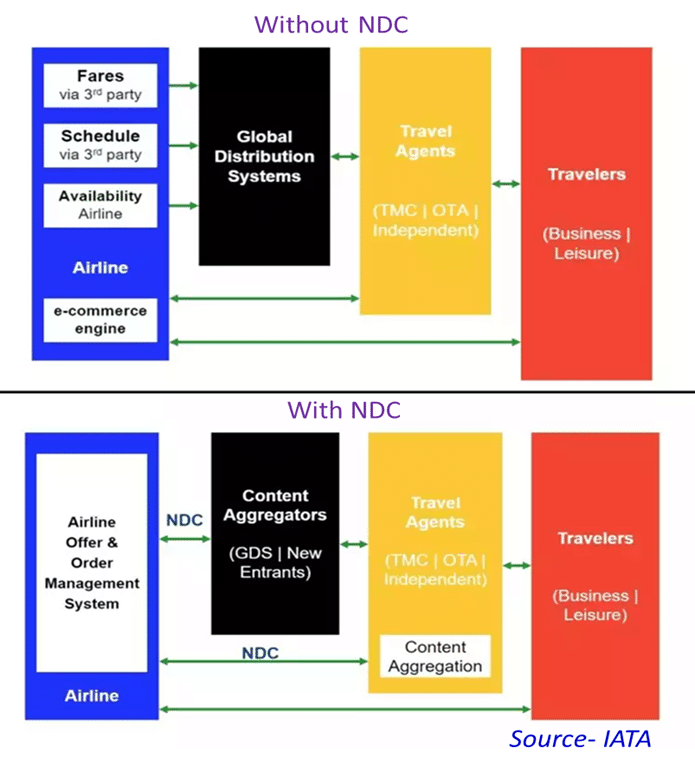Transforming Airline Retailing with New Distribution Capability (NDC)
It will not be an overstatement to say that some of the most revolutionary breakthroughs have been driven by and taken place in the aviation industry. Decades ago, jet engines catapulted the airline industry out of capacity constraints, enabling it to carry many more
It will not be an overstatement to say that some of the most revolutionary breakthroughs have been driven by and taken place in the aviation industry. Decades ago, jet engines catapulted the airline industry out of capacity constraints, enabling it to carry many more travelers. The deregulation of the airline industry provided flexibility and freedom for players to set competitive ticket prices. Together, these allowed airlines to democratize and commercialize travel, but the immediate challenge was reaching out to a large customer base and selling efficiently – Travel Distribution.
The transformation of Computer Reservation Systems (CRS) into Global Distribution Systems (GDS) was the breakthrough that provided much-needed momentum to overcome distribution challenges in the 1960s and 1970s. With travel management companies and organizations like IATA becoming part of the ecosystem, the value chain grew more robust, creating one of the most critical economic drivers.
Today, however, the challenges faced by the airline industry are different, thanks to a newer, more complex equation. The challenges comprise many airline business models, a wide range of distribution channels, and an empowered group of customers and travelers with varying tastes and needs. To thrive in today’s competitive market, airlines must reach out to customers with personalized offers and engage them throughout to maximize lifetime value. This requires a paradigm shift in retail thinking in the travel industry.
If we look at how the retail industry evolved and thrived in today’s world, it was by gathering information about the customer’s tastes and preferences at every touch point. The airline industry wanted to emulate this by collecting traveler data from the point of inspiration to the point of return.

Exhibit: Evolution of travel distribution and airline retailing
New Distribution Capability (NDC)
The conventional distribution technologies introduced in the 1970s posed greater challenges for the industry later. Airlines were limited in their ability to access information about the traveler and their tastes and preferences, which was required to create personalized offers. Traditional airlines that relied on GDS were overshadowed by newcomers who leveraged the internet to sell unbundled products directly to the customer. This continued until the International Air Transport Association (IATA), the body of travel industry standards, came out with the NDC program to create a level playing field for all.

Exhibit- How NDC benefits the stakeholders
How NDC transforms airline retailing
NDC is an airline distribution standard that was introduced in 2012. It is technically an XML-based data-sharing protocol that allows airlines to dynamically package products and ancillaries. Being flexible and not constrained by any software or hardware, XML provides airlines with considerable scaling opportunities to reach rich content directly to the market, be it travel management companies, agencies, or aggregators. This provides several key benefits, including:
- Greater brand and product differentiation opportunities for airlines
- Greater pricing and packaging autonomy
- Richly personalized content enables a better shopping, booking, and travel experience
- A wider marketing and distribution channel network reduces reliance on legacy systems

Exhibit: Retailing before and after NDC
An Expedia study done in 2015 revealed that consumers visit an average of 38 websites before making a booking. Today with digitalization growing faster and apps flooding the market, this number can only be bigger, adding to an airline’s nightmares in terms of differentiating their brand and services in a traveler’s mind. NDC will help airlines solve this challenge.
The two dimensions or capabilities of the airline NDC program are:
- Offer Management: The capability to create and return offers in response to shopping requests. NDC expands the scope of an airline’s merchandising in terms of content, services, and personalization. Moreover, airlines can implement dynamic pricing and control it better.
- Order Management: The ability to create, store, and similarly manage orders in the retail industry, i.e., to have a single order to store the information with regards to the passenger, the itinerary, the ticket information, as well as any other service requests. ONE Order enables Order Management Transition.
ONE Order
ONE Order is a part of and an extension of the airline NDC program that brings order management maturity into airline retailing. While the initial airline NDC program started with creating rich content and offers, ONE Order will standardize the order management process by consolidating the order information into a single Order. This is a good transition from the historical booking process, which consisted of multiple documents for capturing flight schedules and traveler information, ticketing and billing details, and ancillary or special service request details. A single unique order reference helps provide customer information and track the orders from creation through fulfillment.
Achieving Retailing Maturity
Modern retailing places the customer at the center of shopping and fulfillment in an omnichannel engagement model, and airline NDC plays a crucial role in travel retailing. Achieving retail maturity in the travel industry requires airlines to work with their value chain partners – aggregators, travel agents, and travel management companies – to build upon the capabilities of shopping & offers, order creation, and payment.
It is worth mentioning that as of November 2022, IATA has released an Airline Retailing Maturity (ARM) Index that airlines and their partners can use to gain visibility into their own and others’ retailing maturity. This replaces the previous NDC and ONE Order Certification programs. The ARM index categorizes the value chain players into three categories – airlines, sellers, and system and technology providers, and helps assess the retailing capabilities across the following:
- Shop- Flights, Ancillaries, Seat Options, Bundled Offers, Dynamic Pricing
- Order Creation – with or without payments & tickets, Order Cancellation, Group Orders
- Payment – using different modes, Refunds
- Accounting and Settlement
- System setup and technical support
Conclusion
Transforming an airline’s retail maturity requires a strong business case. It also requires revisiting the contracts with partners, including travel agents and system providers. It also means re-engineering the processes related to offers and order management, the scope of which may vary from airline to airline. The most important value derived from this new retailing transition is the increased capability of airlines to drive up profitability through developing new personalized offers, enhancing revenue management capabilities, engaging better with customers, and optimizing fulfillment processes.
Transitioning to XML-based protocols for each use case requires an effective testing approach, and this is where Cigniti can engage with airlines and technology partners to ensure a smooth and error-free transition. Cigniti’s Centers of Excellence (CoE) for Travel & Hospitality, Technology, and Testing collaborate with clients to explore opportunities to speed up turnaround times for each milestone towards achieving the required retail excellence.
Learn more about Cigniti’s Airlines and Travel & Hospitality services, and if you are on a mission to transform your retail landscape, please leave a message so we can help you.





Leave a Reply